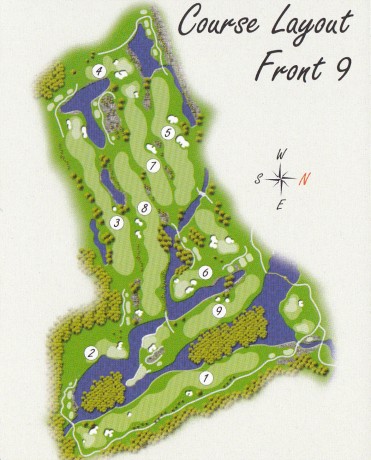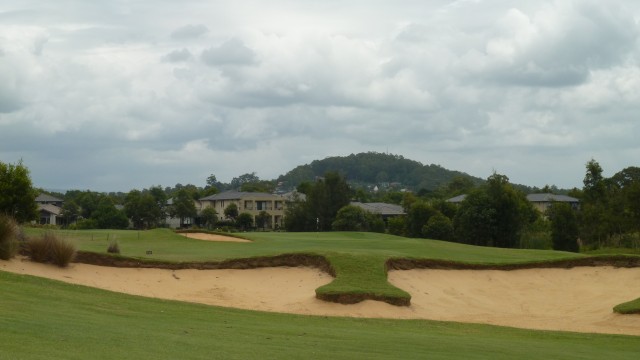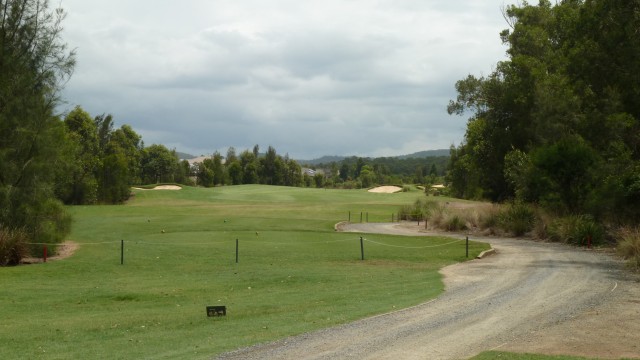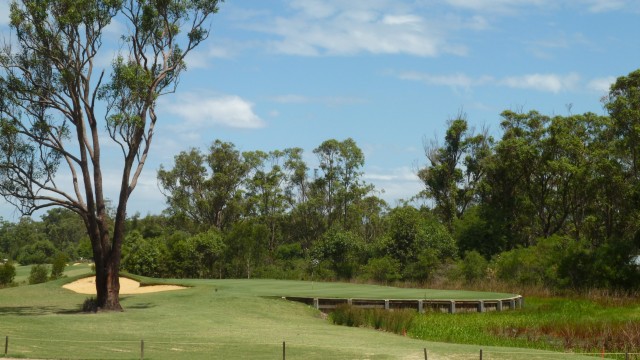
Location: Wyong, NSW
Established: 2006
Architect: Ross Watson
First Played: 16th Jan 2011
Last Played: 16th Jan 2011
Magazine Ratings

96 (2020)

98 (2014)

62 (Current)
Kooindah Waters was established as part of a residential estate and golf resort, north of Sydney in 2006. Designed by Ross Watson, in conjunction with Craig Parry (the ambassador of the club and Australian professional golf champion), the course is managed by the Troon group. Having been fairly newly established this is the courses first appearance in the Golf Digest Top 100 Australian course ranking.
The discussion to play Kooindah Waters had started with my playing partners at Twin Creeks a couple of months before. So the time had finally arrived where our foursome drove the one and a half hour journey up the freeway to Wyong. Our group comprised of regular playing partner Joe (Parramatta), along with Brendan (Ashlar) and John (Warringah). I must admit before leaving the weather was not looking all that great and after hitting the road it only got worse, with rain starting to come down and fog covering parts of the freeway. What were we walking into? Gladly, the further we traveled the less severe the weather became, with it disappearing all together once we arrived.

Entry to the Kooindah Waters estate
The journey served a good time to catch-up on happenings but more importantly stir up the competition between friendly rivals. We managed to get into the local competition for the day so that would add a little more to the competitive spirit.


Map of Kooindah Waters golf course

Scorecard of Kooindah Waters Golf Club
Luckily for us our Brendan had managed to come across a US website were we could pre purchase the green fees for almost a third of the cost (well done Brendan), so we were off to a good start.

The Mantra Resort Clubhouse/Restaurant
The course name certainly informs you that water is abundant on this course. Right from hole one you encounter this and you see plenty off it as you make your way around the course.

The 1st tee gets you away on this shortish par 5
Hole one is relatively straight forward with ample room off the tee to let you settle in to the round. Measuring only 422 meters it is possible to reach the green in two shots. The main danger is water down the right side.

John putting on the 1st green with his home made broomstick
Getting to the first green we saw bunkers with wooden sleepers on the rear face, not so good if you hit that on the fly as the ball could go anywhere. What was the biggest shock was playing partner John pulling out his home made broomstick putter. Was way too long in my opinion, leaving him stretching out too far for the ball. The results showed by the end of the day and I think it got dismantled not long after.

Carry the water on the 2nd – 135 meter par 3
Water is extremely evident on hole 2. This 135 meter par 3 is serene, postcard perfect. Arching around the water body, this hole is all carry to the green. For those wanting a safer route there is a large expanse to the left of the green to bail out, but most golfers would be attacking this hole.

2nd Green
The green is a large kidney shape, slopes down from the middle to the left and right edges. One solitary bunker behind the hole. This is a hole to savour.

Decision time on the 3rd tee shot – 387 meter Par 4
Hole 3 was my favourite for the day. This 365 meter par 4 hole has strategy written all over it. Placement of the tee is critical. The hole is a dogleg left. There are two substantial trees left of the fairway and a bunker to the right. Those ambitious enough to try and carry the trees will need perfect placement as the fairway is narrow beyond and water can be found left and right of the fairway. For those smart enough there is generous fairway to the right, but this leaves a long shot to the green.

The 3rd green has a ridge through the middle
Closer to the hole the fairway widens, but heavy trees are left and further water on the right, which the fairway slopes towards. The green with bunkers left and right, is narrow but quite long, with two distinct tiers, ensuring you hit the right portion to make par possible.

478 Meter Par 5 – View from the tee Hole 5
A tight tee shot on the fifth, with netting down the left imposing a little to protect the housing. You play over water to reach the fairway but bunkers also await.

The 5th green
One thing could be commended was the consistency in the bunkers, not that you really should be finding you way in them.

Short par 3 measuring 126 meters is found at the 6th
The easiest hole on the course, the 6th is a shortish par 3. Bunkers surround most of the front of the green but there is also a tree which can come into play on the right. The green is slightly elevated with a few mounds in the front section.

Me in action on the 7th tee

Approaching the green on the 8th
Hole 8 is a genuine par 5, and a great test. Only the longest of hitters will reach in two, not because of distance but due to design. The tee shot allows ample room to hit the fairway, with only the worst tee shots finding trouble in trees on both sides. Two fairway bunkers may come into play on the right for longer hitters, but most people should be fairly safe. The next shot is where trouble can start, especially those that have not researched the hole. Leading up to the green there is a water hazard left, but also running along the front of the green. The left side of the front portion is partially hidden by the gentle slope leading down just before the hazard, which could lead the player to believe that this part is fairway to run the ball beside the green.

Approach to the 8th green
Two of my playing partners found out this the hard way. Failure to leave the shot short will blow any chance of par. The third is over the hazard to a large green sloping towards the water. Too much spin close to the front edge will see the ball roll over the wooden wall at the front of the green into a watery grave. A large bunker is at the back to catch any long shot, another place to avoid. No-one really likes playing a bunker shot with water on the other side of the green. There is quite a lot of gradient so two putts are not guaranteed on this hole.

Looking back on the 8th – 475 meter Par 5
A great way to finish the front nine is this 323 meter par 4. This slightly dogleg right hole is intimidating as well as picturesque. If played from the tips, where you have to walk out onto a section built up over the water it becomes even harder. The tee shot is to a generous fairway, but does have trouble right and left. This is one hole you have to hit the fairway to have any chance at par. Towards the end of the fairway two bunkers are located to the left and center.

Approach to the 9th green
The optimum tee shot would be to the right of the center bunker, leaving around 110 meters to the hole. To reach the green you have to carry a water hazard to a smallish pear shaped green. This undulating green, slopes left to right and back to front. If the pin is far left the shot will be a gem which you should be proud of to keep on the green and close to the pin. Beyond the green is a small swale and a large bunker, which should not come into play.

Clubhouse view of the 9th – 354 meter Par 4
A great way to enjoy the view of the 9th hole is from the clubhouse. There is action a plenty watching those carry the water to the green. It is a superb spectacle but not great design wise as there is no other way to the green unless you can walk on water, or play putt putt along the bridge from fairway to green.


The Hole markers and typical water wildlife on the course

Hole 10 – Rated the least difficult of all the par 5 holes
Heading out after a quick drink break, we reach the 10th tee. This has a small carry over wetlands to reach the fairway, with a trap right of the landing area. This leaves the best approach to the green for long hitters. There is a lot of space to land the ball however from the tee.

View from the 10th Fairway – a 461 meter par 5
On the approach to the green a large tree can come into play on the left side, so best to stick to the right side of the fairway with the second shot.

The large 10th green
There is not too much trouble to be found on the green. If you have reach here in 3 you should have an easy par.

The 11th tee – 351 meter par 4
Water can be found down the right side of this hole so ensure you stay clear. Potentially the trap on the left can come into play off the tee.

The 11th fairway
From the left side, the approach to the green brings into play another bunker. The green has some gentle slopes to contend with.

Brendan teeing up on the 176 meter Par 3 – Hole 12 (John won nearest the pin here)
A long par 3 is found at the 12th. Sand is found on both sides with water also on the left. A nice opening is found up the middle letting anything slightly short with a chance of running on. Also great for those that can’t hit the ball far.

The different bunker systems – Fairway in the foreground and timber lined greenside background – 13th
This 353 meter par 4 is a challenging hole with a well placed drive required to allow an easier shot to the green. Wetlands comes into play in front of the green and will need to be carried to reach some pin positions. This picture shows the contrasting bunker systems found on the course, with the traditional bunkers found at most courses in the foreground, whilst the greenside bunkers have the wooden sleepers at the rear. This does allow you to see them however from a distance which is quite handy, rather than coming to the green to find the ball in the sand.

Approach to the 15th green – 536 meter Par 5
Hole 15, the longest par 5 on the course at 513 meters, is quite a challenge. Off the tee you can feel the shoulders open, ready to hit the ball deep down the fairway. This is not the widest of fairways and position is paramount, to enable you to strategically place the second shot, either attacking the green or allowing for an easy approach. From the tee bunkers are in play left and right. For any errant shot wetland runs the entire left length of the hole. The water down the right should not really come into play.

The 15th green at Kooindah Waters golf club
A big decision is required for the second shot. Those long enough may have a chance to hit the green, but will definitely bring the water into play. The thoughts are now all about positioning for the approach. Two further fairway bunkers are located 130 meters from the hole, so there is a decision on carrying these or laying up short. Approaching the green should be done to the right as the green slopes towards the water, which protects most of the left side of the green. Three bunkers are located to the right and behind, with the typical Kooindah wooden sleepers at the rear of them. The green is very large and fairly flat overall. Two putts no guarantee if you don’t hit to the correct portion of the green.

Picturesque par 3 – 126 meter 17th – taken from the 16th green
The last par 3 on the course, hole 17 is a fairly short at 116 meters. This is an island green, so you must carry the wetlands to reach. Hitting the correct area of the green will be critical to par, as the green slopes from back to front and has a bit of length.

Carry the water to reach the 17th green
A bunker is in play on the left and will leave a tough shot out, if the pin is towards to the front of the green. The penultimate hole is very picturesque.

View of the 18th green – 397 meter Par 4
Hole 18 is a great way to finish the round. At 382 meters this long par 4 has water running the entire length on the left. Bunkers come into play on the right from the tee shot. Aiming at the right bunker should see safety. The approach to the green is a long shot which carries a creek 75 meters short of the green.

18th green – taken from practice facilities
This should not come into play unless you mishit your approach. The green sits up against the water on the left and is protected by bunkers on the right. This site is a great visual to walk away from the course with.

Brendan, John, Joe and myself
The course has a great clubhouse, so we definitely enjoyed the 19th, with views overlooking the 9th and 18th greens, as well as the 10th fairway. This is an enjoyable course to play and should see it jump up the rankings in 2012.
Kooindah Waters is open to the public 7 days a week (unless there is a corporate event on) so there should not be too much issues getting a game.
Note – Game was played from the gold tees

